Impact of Pricing Strategies on Consumer Behavior: Research Proposal
VerifiedAdded on 2022/10/04
|13
|3988
|185
Report
AI Summary
This report is a research proposal that investigates the impact of pricing strategies on consumer buying behavior within the retail industry, using Aldi as a case study. The proposal outlines the research aim, objectives, questions, and hypotheses, with a rationale emphasizing the importance of effective pricing in a competitive market. The methodology section details the research philosophy (pragmatism), approach (deductive), and design (explanatory, sequential explanatory). It also describes data collection methods, including primary and secondary data, and analysis techniques. The proposal addresses the research onion framework, covering various aspects of the research process. The study aims to contribute to the understanding of pricing strategies and their influence on consumer purchase decisions, providing valuable insights for retail managers and offering recommendations for developing sustainable competitive advantages. The research will use both quantitative and qualitative techniques for data collection and analysis by using the pragmatism philosophy.
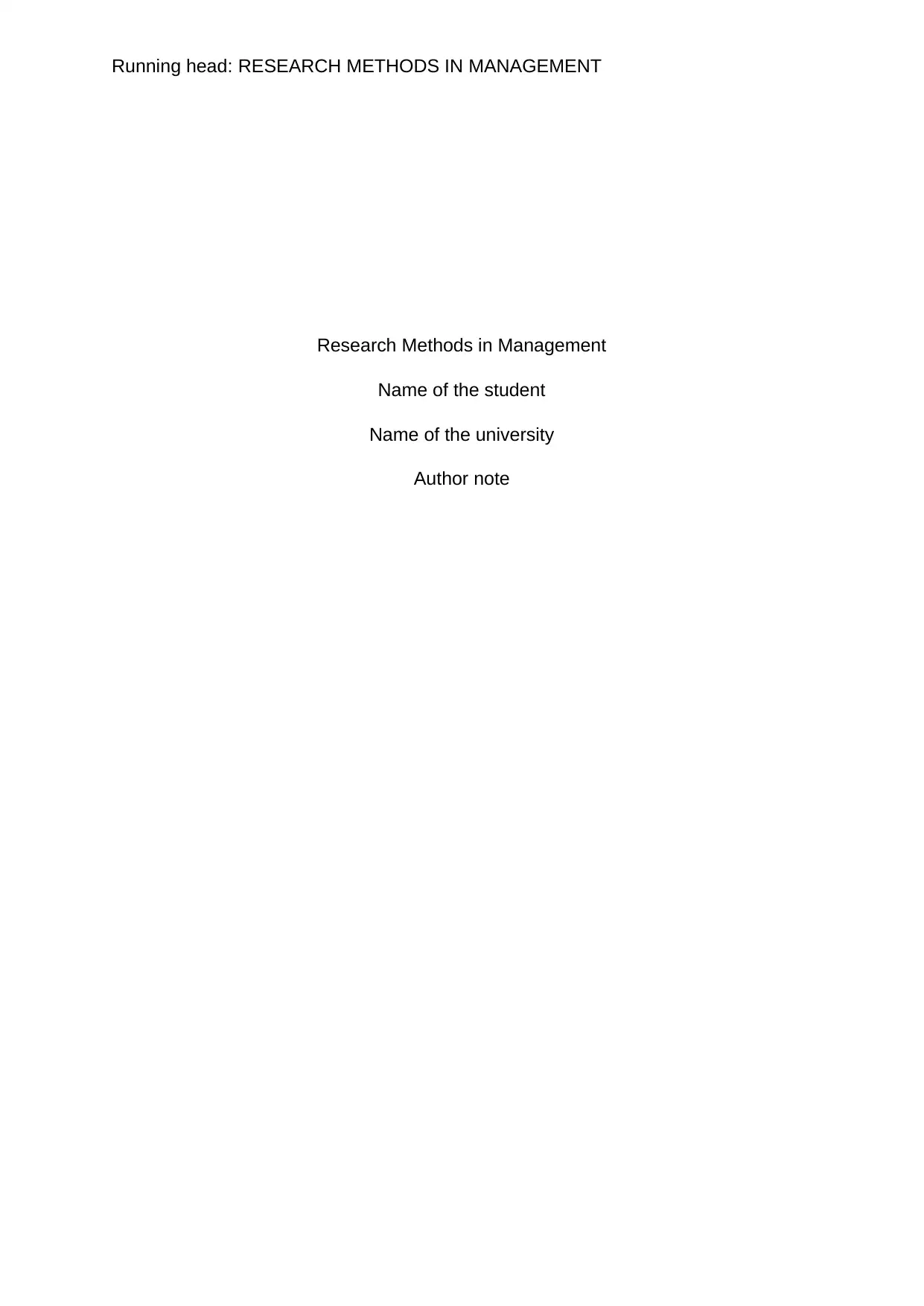
Running head: RESEARCH METHODS IN MANAGEMENT
Research Methods in Management
Name of the student
Name of the university
Author note
Research Methods in Management
Name of the student
Name of the university
Author note
Paraphrase This Document
Need a fresh take? Get an instant paraphrase of this document with our AI Paraphraser
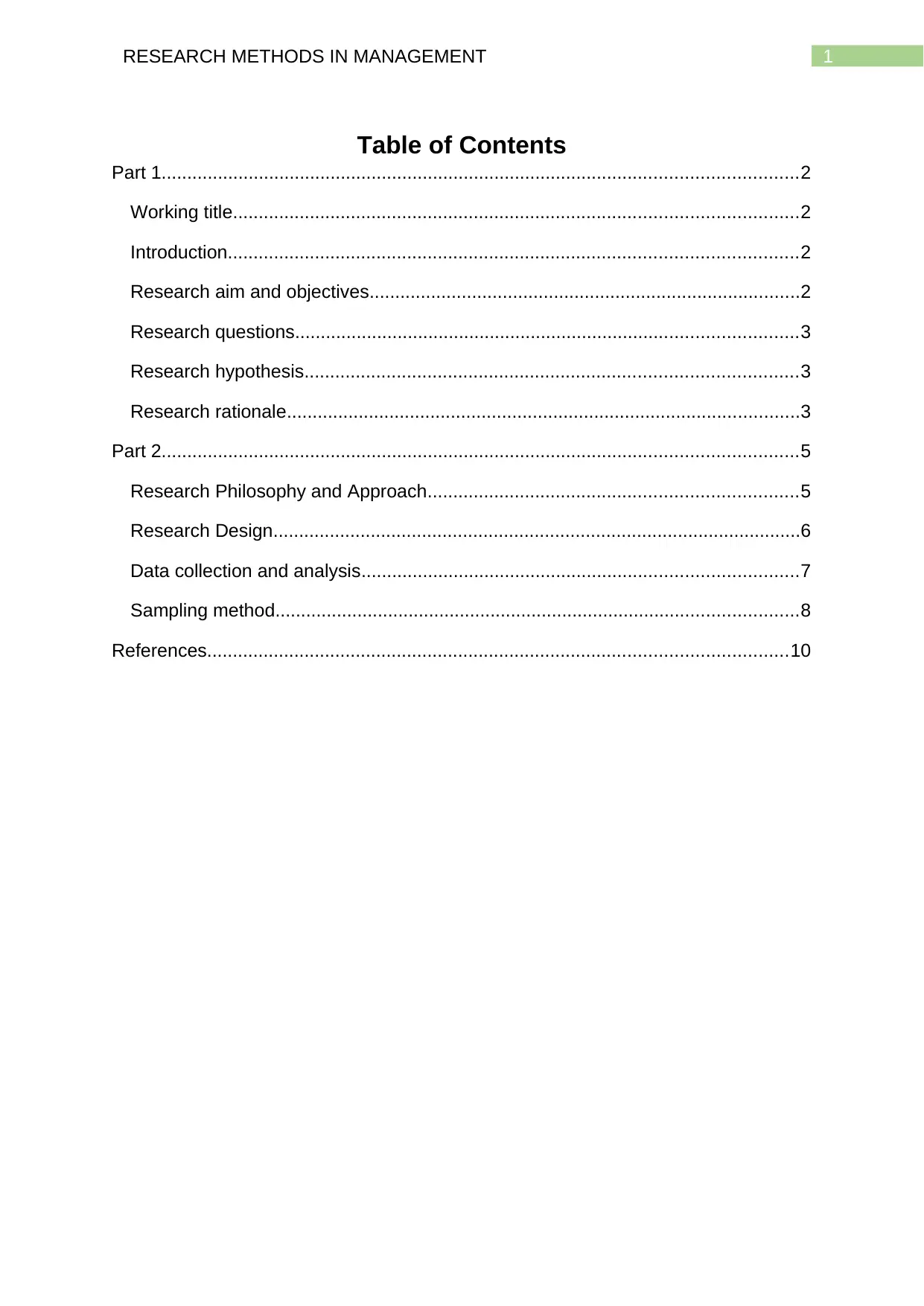
1RESEARCH METHODS IN MANAGEMENT
Table of Contents
Part 1............................................................................................................................2
Working title..............................................................................................................2
Introduction...............................................................................................................2
Research aim and objectives....................................................................................2
Research questions..................................................................................................3
Research hypothesis................................................................................................3
Research rationale....................................................................................................3
Part 2............................................................................................................................5
Research Philosophy and Approach........................................................................5
Research Design.......................................................................................................6
Data collection and analysis.....................................................................................7
Sampling method......................................................................................................8
References.................................................................................................................10
Table of Contents
Part 1............................................................................................................................2
Working title..............................................................................................................2
Introduction...............................................................................................................2
Research aim and objectives....................................................................................2
Research questions..................................................................................................3
Research hypothesis................................................................................................3
Research rationale....................................................................................................3
Part 2............................................................................................................................5
Research Philosophy and Approach........................................................................5
Research Design.......................................................................................................6
Data collection and analysis.....................................................................................7
Sampling method......................................................................................................8
References.................................................................................................................10
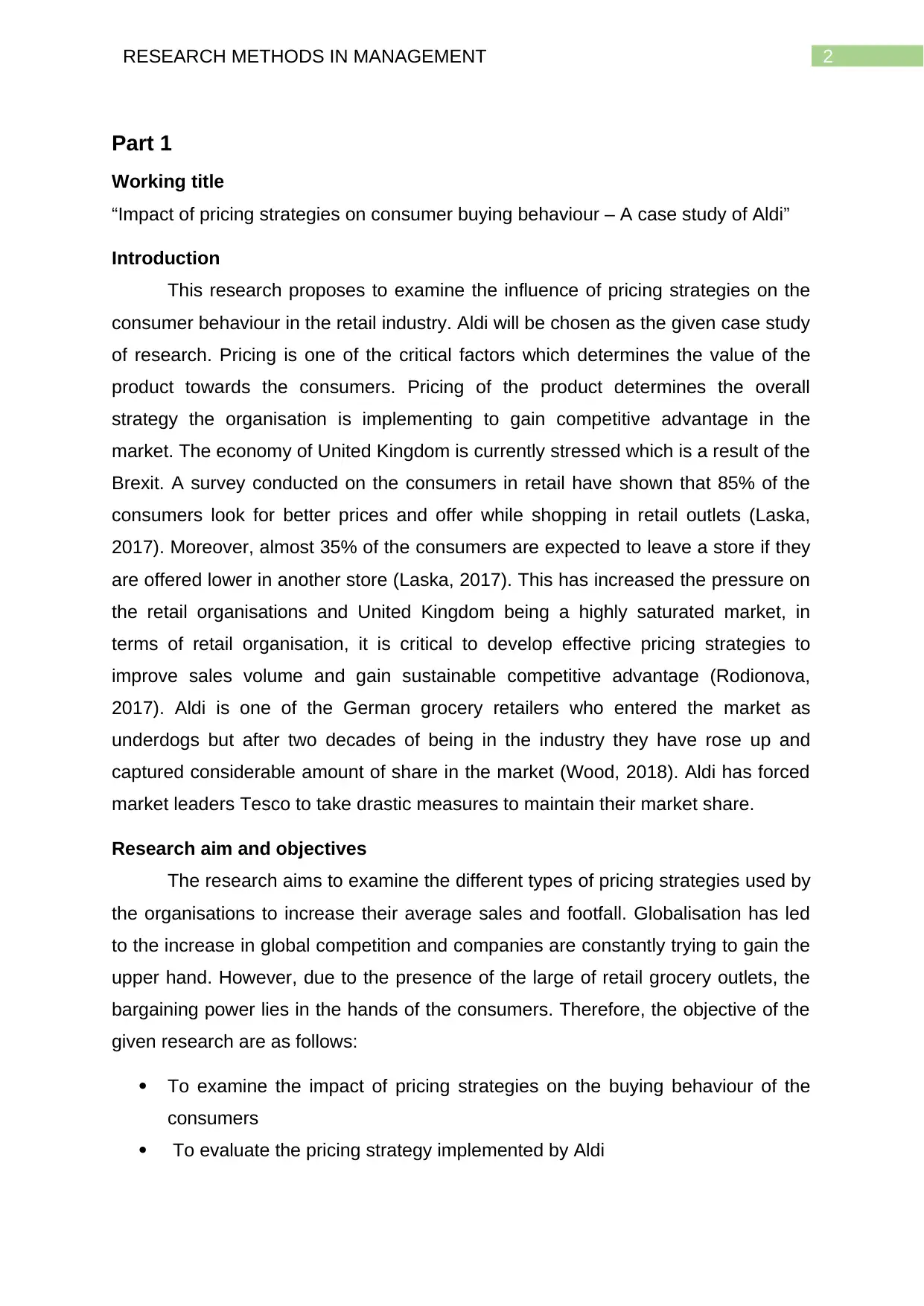
2RESEARCH METHODS IN MANAGEMENT
Part 1
Working title
“Impact of pricing strategies on consumer buying behaviour – A case study of Aldi”
Introduction
This research proposes to examine the influence of pricing strategies on the
consumer behaviour in the retail industry. Aldi will be chosen as the given case study
of research. Pricing is one of the critical factors which determines the value of the
product towards the consumers. Pricing of the product determines the overall
strategy the organisation is implementing to gain competitive advantage in the
market. The economy of United Kingdom is currently stressed which is a result of the
Brexit. A survey conducted on the consumers in retail have shown that 85% of the
consumers look for better prices and offer while shopping in retail outlets (Laska,
2017). Moreover, almost 35% of the consumers are expected to leave a store if they
are offered lower in another store (Laska, 2017). This has increased the pressure on
the retail organisations and United Kingdom being a highly saturated market, in
terms of retail organisation, it is critical to develop effective pricing strategies to
improve sales volume and gain sustainable competitive advantage (Rodionova,
2017). Aldi is one of the German grocery retailers who entered the market as
underdogs but after two decades of being in the industry they have rose up and
captured considerable amount of share in the market (Wood, 2018). Aldi has forced
market leaders Tesco to take drastic measures to maintain their market share.
Research aim and objectives
The research aims to examine the different types of pricing strategies used by
the organisations to increase their average sales and footfall. Globalisation has led
to the increase in global competition and companies are constantly trying to gain the
upper hand. However, due to the presence of the large of retail grocery outlets, the
bargaining power lies in the hands of the consumers. Therefore, the objective of the
given research are as follows:
To examine the impact of pricing strategies on the buying behaviour of the
consumers
To evaluate the pricing strategy implemented by Aldi
Part 1
Working title
“Impact of pricing strategies on consumer buying behaviour – A case study of Aldi”
Introduction
This research proposes to examine the influence of pricing strategies on the
consumer behaviour in the retail industry. Aldi will be chosen as the given case study
of research. Pricing is one of the critical factors which determines the value of the
product towards the consumers. Pricing of the product determines the overall
strategy the organisation is implementing to gain competitive advantage in the
market. The economy of United Kingdom is currently stressed which is a result of the
Brexit. A survey conducted on the consumers in retail have shown that 85% of the
consumers look for better prices and offer while shopping in retail outlets (Laska,
2017). Moreover, almost 35% of the consumers are expected to leave a store if they
are offered lower in another store (Laska, 2017). This has increased the pressure on
the retail organisations and United Kingdom being a highly saturated market, in
terms of retail organisation, it is critical to develop effective pricing strategies to
improve sales volume and gain sustainable competitive advantage (Rodionova,
2017). Aldi is one of the German grocery retailers who entered the market as
underdogs but after two decades of being in the industry they have rose up and
captured considerable amount of share in the market (Wood, 2018). Aldi has forced
market leaders Tesco to take drastic measures to maintain their market share.
Research aim and objectives
The research aims to examine the different types of pricing strategies used by
the organisations to increase their average sales and footfall. Globalisation has led
to the increase in global competition and companies are constantly trying to gain the
upper hand. However, due to the presence of the large of retail grocery outlets, the
bargaining power lies in the hands of the consumers. Therefore, the objective of the
given research are as follows:
To examine the impact of pricing strategies on the buying behaviour of the
consumers
To evaluate the pricing strategy implemented by Aldi
⊘ This is a preview!⊘
Do you want full access?
Subscribe today to unlock all pages.

Trusted by 1+ million students worldwide
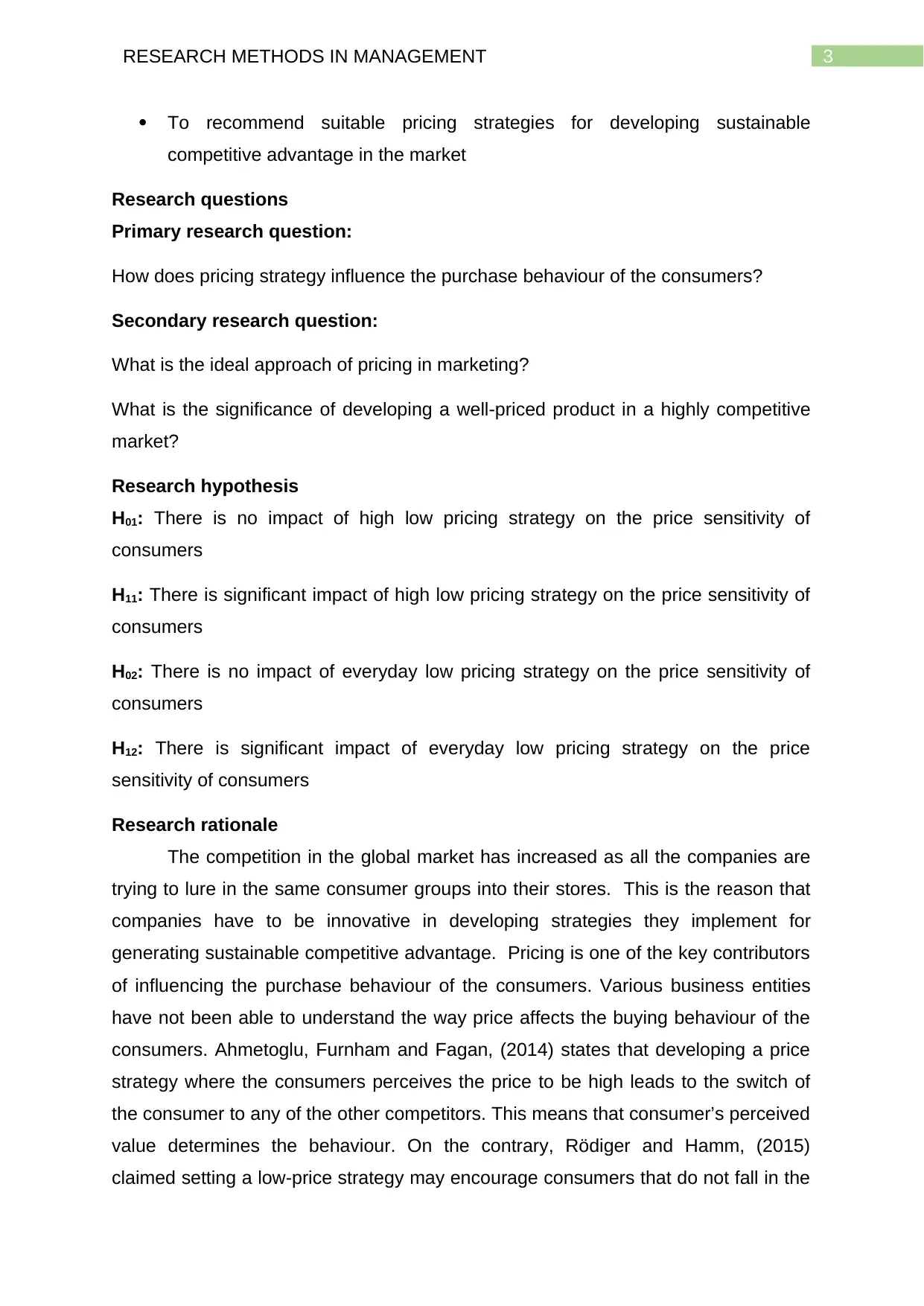
3RESEARCH METHODS IN MANAGEMENT
To recommend suitable pricing strategies for developing sustainable
competitive advantage in the market
Research questions
Primary research question:
How does pricing strategy influence the purchase behaviour of the consumers?
Secondary research question:
What is the ideal approach of pricing in marketing?
What is the significance of developing a well-priced product in a highly competitive
market?
Research hypothesis
H01: There is no impact of high low pricing strategy on the price sensitivity of
consumers
H11: There is significant impact of high low pricing strategy on the price sensitivity of
consumers
H02: There is no impact of everyday low pricing strategy on the price sensitivity of
consumers
H12: There is significant impact of everyday low pricing strategy on the price
sensitivity of consumers
Research rationale
The competition in the global market has increased as all the companies are
trying to lure in the same consumer groups into their stores. This is the reason that
companies have to be innovative in developing strategies they implement for
generating sustainable competitive advantage. Pricing is one of the key contributors
of influencing the purchase behaviour of the consumers. Various business entities
have not been able to understand the way price affects the buying behaviour of the
consumers. Ahmetoglu, Furnham and Fagan, (2014) states that developing a price
strategy where the consumers perceives the price to be high leads to the switch of
the consumer to any of the other competitors. This means that consumer’s perceived
value determines the behaviour. On the contrary, Rödiger and Hamm, (2015)
claimed setting a low-price strategy may encourage consumers that do not fall in the
To recommend suitable pricing strategies for developing sustainable
competitive advantage in the market
Research questions
Primary research question:
How does pricing strategy influence the purchase behaviour of the consumers?
Secondary research question:
What is the ideal approach of pricing in marketing?
What is the significance of developing a well-priced product in a highly competitive
market?
Research hypothesis
H01: There is no impact of high low pricing strategy on the price sensitivity of
consumers
H11: There is significant impact of high low pricing strategy on the price sensitivity of
consumers
H02: There is no impact of everyday low pricing strategy on the price sensitivity of
consumers
H12: There is significant impact of everyday low pricing strategy on the price
sensitivity of consumers
Research rationale
The competition in the global market has increased as all the companies are
trying to lure in the same consumer groups into their stores. This is the reason that
companies have to be innovative in developing strategies they implement for
generating sustainable competitive advantage. Pricing is one of the key contributors
of influencing the purchase behaviour of the consumers. Various business entities
have not been able to understand the way price affects the buying behaviour of the
consumers. Ahmetoglu, Furnham and Fagan, (2014) states that developing a price
strategy where the consumers perceives the price to be high leads to the switch of
the consumer to any of the other competitors. This means that consumer’s perceived
value determines the behaviour. On the contrary, Rödiger and Hamm, (2015)
claimed setting a low-price strategy may encourage consumers that do not fall in the
Paraphrase This Document
Need a fresh take? Get an instant paraphrase of this document with our AI Paraphraser
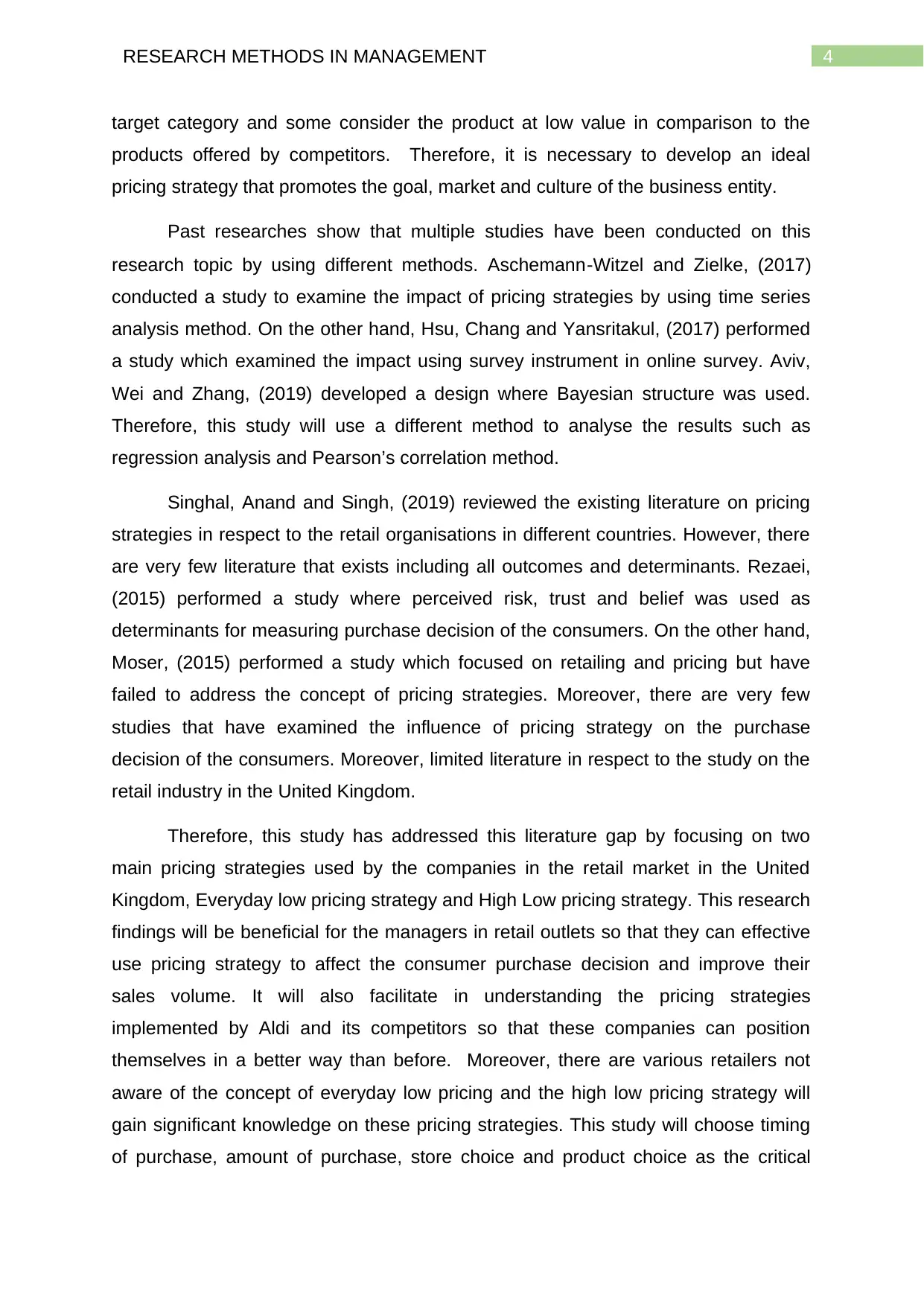
4RESEARCH METHODS IN MANAGEMENT
target category and some consider the product at low value in comparison to the
products offered by competitors. Therefore, it is necessary to develop an ideal
pricing strategy that promotes the goal, market and culture of the business entity.
Past researches show that multiple studies have been conducted on this
research topic by using different methods. Aschemann‐Witzel and Zielke, (2017)
conducted a study to examine the impact of pricing strategies by using time series
analysis method. On the other hand, Hsu, Chang and Yansritakul, (2017) performed
a study which examined the impact using survey instrument in online survey. Aviv,
Wei and Zhang, (2019) developed a design where Bayesian structure was used.
Therefore, this study will use a different method to analyse the results such as
regression analysis and Pearson’s correlation method.
Singhal, Anand and Singh, (2019) reviewed the existing literature on pricing
strategies in respect to the retail organisations in different countries. However, there
are very few literature that exists including all outcomes and determinants. Rezaei,
(2015) performed a study where perceived risk, trust and belief was used as
determinants for measuring purchase decision of the consumers. On the other hand,
Moser, (2015) performed a study which focused on retailing and pricing but have
failed to address the concept of pricing strategies. Moreover, there are very few
studies that have examined the influence of pricing strategy on the purchase
decision of the consumers. Moreover, limited literature in respect to the study on the
retail industry in the United Kingdom.
Therefore, this study has addressed this literature gap by focusing on two
main pricing strategies used by the companies in the retail market in the United
Kingdom, Everyday low pricing strategy and High Low pricing strategy. This research
findings will be beneficial for the managers in retail outlets so that they can effective
use pricing strategy to affect the consumer purchase decision and improve their
sales volume. It will also facilitate in understanding the pricing strategies
implemented by Aldi and its competitors so that these companies can position
themselves in a better way than before. Moreover, there are various retailers not
aware of the concept of everyday low pricing and the high low pricing strategy will
gain significant knowledge on these pricing strategies. This study will choose timing
of purchase, amount of purchase, store choice and product choice as the critical
target category and some consider the product at low value in comparison to the
products offered by competitors. Therefore, it is necessary to develop an ideal
pricing strategy that promotes the goal, market and culture of the business entity.
Past researches show that multiple studies have been conducted on this
research topic by using different methods. Aschemann‐Witzel and Zielke, (2017)
conducted a study to examine the impact of pricing strategies by using time series
analysis method. On the other hand, Hsu, Chang and Yansritakul, (2017) performed
a study which examined the impact using survey instrument in online survey. Aviv,
Wei and Zhang, (2019) developed a design where Bayesian structure was used.
Therefore, this study will use a different method to analyse the results such as
regression analysis and Pearson’s correlation method.
Singhal, Anand and Singh, (2019) reviewed the existing literature on pricing
strategies in respect to the retail organisations in different countries. However, there
are very few literature that exists including all outcomes and determinants. Rezaei,
(2015) performed a study where perceived risk, trust and belief was used as
determinants for measuring purchase decision of the consumers. On the other hand,
Moser, (2015) performed a study which focused on retailing and pricing but have
failed to address the concept of pricing strategies. Moreover, there are very few
studies that have examined the influence of pricing strategy on the purchase
decision of the consumers. Moreover, limited literature in respect to the study on the
retail industry in the United Kingdom.
Therefore, this study has addressed this literature gap by focusing on two
main pricing strategies used by the companies in the retail market in the United
Kingdom, Everyday low pricing strategy and High Low pricing strategy. This research
findings will be beneficial for the managers in retail outlets so that they can effective
use pricing strategy to affect the consumer purchase decision and improve their
sales volume. It will also facilitate in understanding the pricing strategies
implemented by Aldi and its competitors so that these companies can position
themselves in a better way than before. Moreover, there are various retailers not
aware of the concept of everyday low pricing and the high low pricing strategy will
gain significant knowledge on these pricing strategies. This study will choose timing
of purchase, amount of purchase, store choice and product choice as the critical
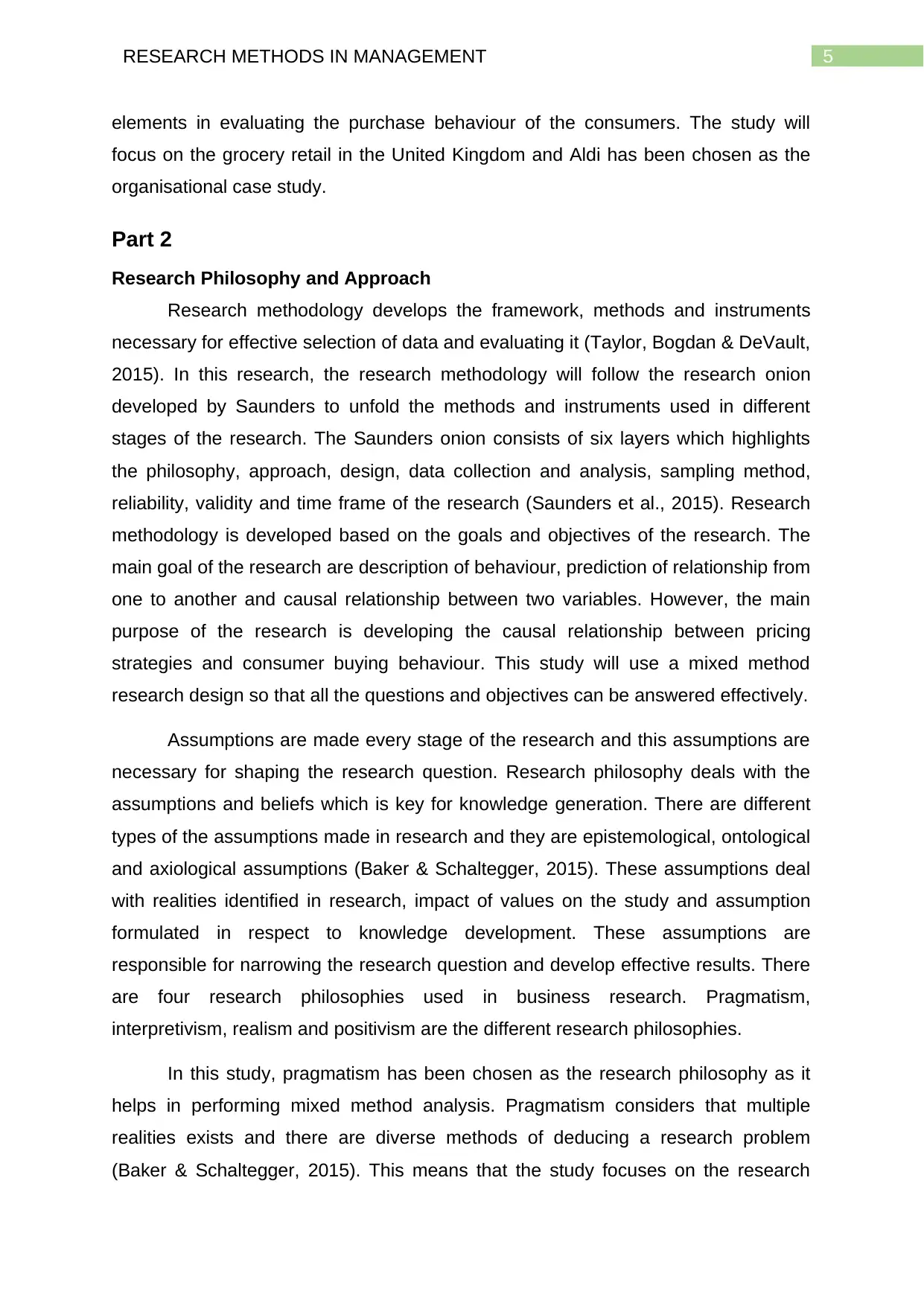
5RESEARCH METHODS IN MANAGEMENT
elements in evaluating the purchase behaviour of the consumers. The study will
focus on the grocery retail in the United Kingdom and Aldi has been chosen as the
organisational case study.
Part 2
Research Philosophy and Approach
Research methodology develops the framework, methods and instruments
necessary for effective selection of data and evaluating it (Taylor, Bogdan & DeVault,
2015). In this research, the research methodology will follow the research onion
developed by Saunders to unfold the methods and instruments used in different
stages of the research. The Saunders onion consists of six layers which highlights
the philosophy, approach, design, data collection and analysis, sampling method,
reliability, validity and time frame of the research (Saunders et al., 2015). Research
methodology is developed based on the goals and objectives of the research. The
main goal of the research are description of behaviour, prediction of relationship from
one to another and causal relationship between two variables. However, the main
purpose of the research is developing the causal relationship between pricing
strategies and consumer buying behaviour. This study will use a mixed method
research design so that all the questions and objectives can be answered effectively.
Assumptions are made every stage of the research and this assumptions are
necessary for shaping the research question. Research philosophy deals with the
assumptions and beliefs which is key for knowledge generation. There are different
types of the assumptions made in research and they are epistemological, ontological
and axiological assumptions (Baker & Schaltegger, 2015). These assumptions deal
with realities identified in research, impact of values on the study and assumption
formulated in respect to knowledge development. These assumptions are
responsible for narrowing the research question and develop effective results. There
are four research philosophies used in business research. Pragmatism,
interpretivism, realism and positivism are the different research philosophies.
In this study, pragmatism has been chosen as the research philosophy as it
helps in performing mixed method analysis. Pragmatism considers that multiple
realities exists and there are diverse methods of deducing a research problem
(Baker & Schaltegger, 2015). This means that the study focuses on the research
elements in evaluating the purchase behaviour of the consumers. The study will
focus on the grocery retail in the United Kingdom and Aldi has been chosen as the
organisational case study.
Part 2
Research Philosophy and Approach
Research methodology develops the framework, methods and instruments
necessary for effective selection of data and evaluating it (Taylor, Bogdan & DeVault,
2015). In this research, the research methodology will follow the research onion
developed by Saunders to unfold the methods and instruments used in different
stages of the research. The Saunders onion consists of six layers which highlights
the philosophy, approach, design, data collection and analysis, sampling method,
reliability, validity and time frame of the research (Saunders et al., 2015). Research
methodology is developed based on the goals and objectives of the research. The
main goal of the research are description of behaviour, prediction of relationship from
one to another and causal relationship between two variables. However, the main
purpose of the research is developing the causal relationship between pricing
strategies and consumer buying behaviour. This study will use a mixed method
research design so that all the questions and objectives can be answered effectively.
Assumptions are made every stage of the research and this assumptions are
necessary for shaping the research question. Research philosophy deals with the
assumptions and beliefs which is key for knowledge generation. There are different
types of the assumptions made in research and they are epistemological, ontological
and axiological assumptions (Baker & Schaltegger, 2015). These assumptions deal
with realities identified in research, impact of values on the study and assumption
formulated in respect to knowledge development. These assumptions are
responsible for narrowing the research question and develop effective results. There
are four research philosophies used in business research. Pragmatism,
interpretivism, realism and positivism are the different research philosophies.
In this study, pragmatism has been chosen as the research philosophy as it
helps in performing mixed method analysis. Pragmatism considers that multiple
realities exists and there are diverse methods of deducing a research problem
(Baker & Schaltegger, 2015). This means that the study focuses on the research
⊘ This is a preview!⊘
Do you want full access?
Subscribe today to unlock all pages.

Trusted by 1+ million students worldwide
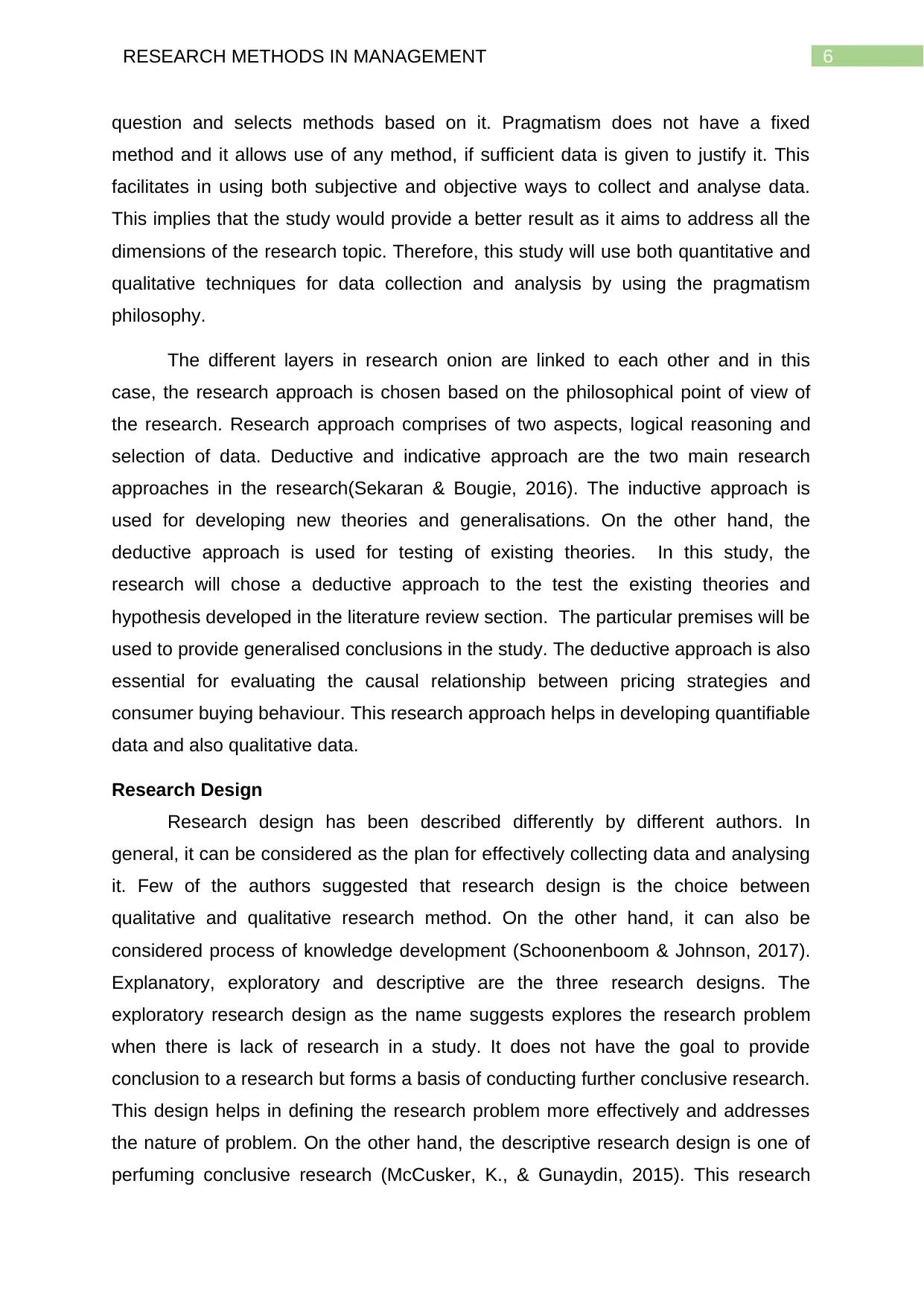
6RESEARCH METHODS IN MANAGEMENT
question and selects methods based on it. Pragmatism does not have a fixed
method and it allows use of any method, if sufficient data is given to justify it. This
facilitates in using both subjective and objective ways to collect and analyse data.
This implies that the study would provide a better result as it aims to address all the
dimensions of the research topic. Therefore, this study will use both quantitative and
qualitative techniques for data collection and analysis by using the pragmatism
philosophy.
The different layers in research onion are linked to each other and in this
case, the research approach is chosen based on the philosophical point of view of
the research. Research approach comprises of two aspects, logical reasoning and
selection of data. Deductive and indicative approach are the two main research
approaches in the research(Sekaran & Bougie, 2016). The inductive approach is
used for developing new theories and generalisations. On the other hand, the
deductive approach is used for testing of existing theories. In this study, the
research will chose a deductive approach to the test the existing theories and
hypothesis developed in the literature review section. The particular premises will be
used to provide generalised conclusions in the study. The deductive approach is also
essential for evaluating the causal relationship between pricing strategies and
consumer buying behaviour. This research approach helps in developing quantifiable
data and also qualitative data.
Research Design
Research design has been described differently by different authors. In
general, it can be considered as the plan for effectively collecting data and analysing
it. Few of the authors suggested that research design is the choice between
qualitative and qualitative research method. On the other hand, it can also be
considered process of knowledge development (Schoonenboom & Johnson, 2017).
Explanatory, exploratory and descriptive are the three research designs. The
exploratory research design as the name suggests explores the research problem
when there is lack of research in a study. It does not have the goal to provide
conclusion to a research but forms a basis of conducting further conclusive research.
This design helps in defining the research problem more effectively and addresses
the nature of problem. On the other hand, the descriptive research design is one of
perfuming conclusive research (McCusker, K., & Gunaydin, 2015). This research
question and selects methods based on it. Pragmatism does not have a fixed
method and it allows use of any method, if sufficient data is given to justify it. This
facilitates in using both subjective and objective ways to collect and analyse data.
This implies that the study would provide a better result as it aims to address all the
dimensions of the research topic. Therefore, this study will use both quantitative and
qualitative techniques for data collection and analysis by using the pragmatism
philosophy.
The different layers in research onion are linked to each other and in this
case, the research approach is chosen based on the philosophical point of view of
the research. Research approach comprises of two aspects, logical reasoning and
selection of data. Deductive and indicative approach are the two main research
approaches in the research(Sekaran & Bougie, 2016). The inductive approach is
used for developing new theories and generalisations. On the other hand, the
deductive approach is used for testing of existing theories. In this study, the
research will chose a deductive approach to the test the existing theories and
hypothesis developed in the literature review section. The particular premises will be
used to provide generalised conclusions in the study. The deductive approach is also
essential for evaluating the causal relationship between pricing strategies and
consumer buying behaviour. This research approach helps in developing quantifiable
data and also qualitative data.
Research Design
Research design has been described differently by different authors. In
general, it can be considered as the plan for effectively collecting data and analysing
it. Few of the authors suggested that research design is the choice between
qualitative and qualitative research method. On the other hand, it can also be
considered process of knowledge development (Schoonenboom & Johnson, 2017).
Explanatory, exploratory and descriptive are the three research designs. The
exploratory research design as the name suggests explores the research problem
when there is lack of research in a study. It does not have the goal to provide
conclusion to a research but forms a basis of conducting further conclusive research.
This design helps in defining the research problem more effectively and addresses
the nature of problem. On the other hand, the descriptive research design is one of
perfuming conclusive research (McCusker, K., & Gunaydin, 2015). This research
Paraphrase This Document
Need a fresh take? Get an instant paraphrase of this document with our AI Paraphraser
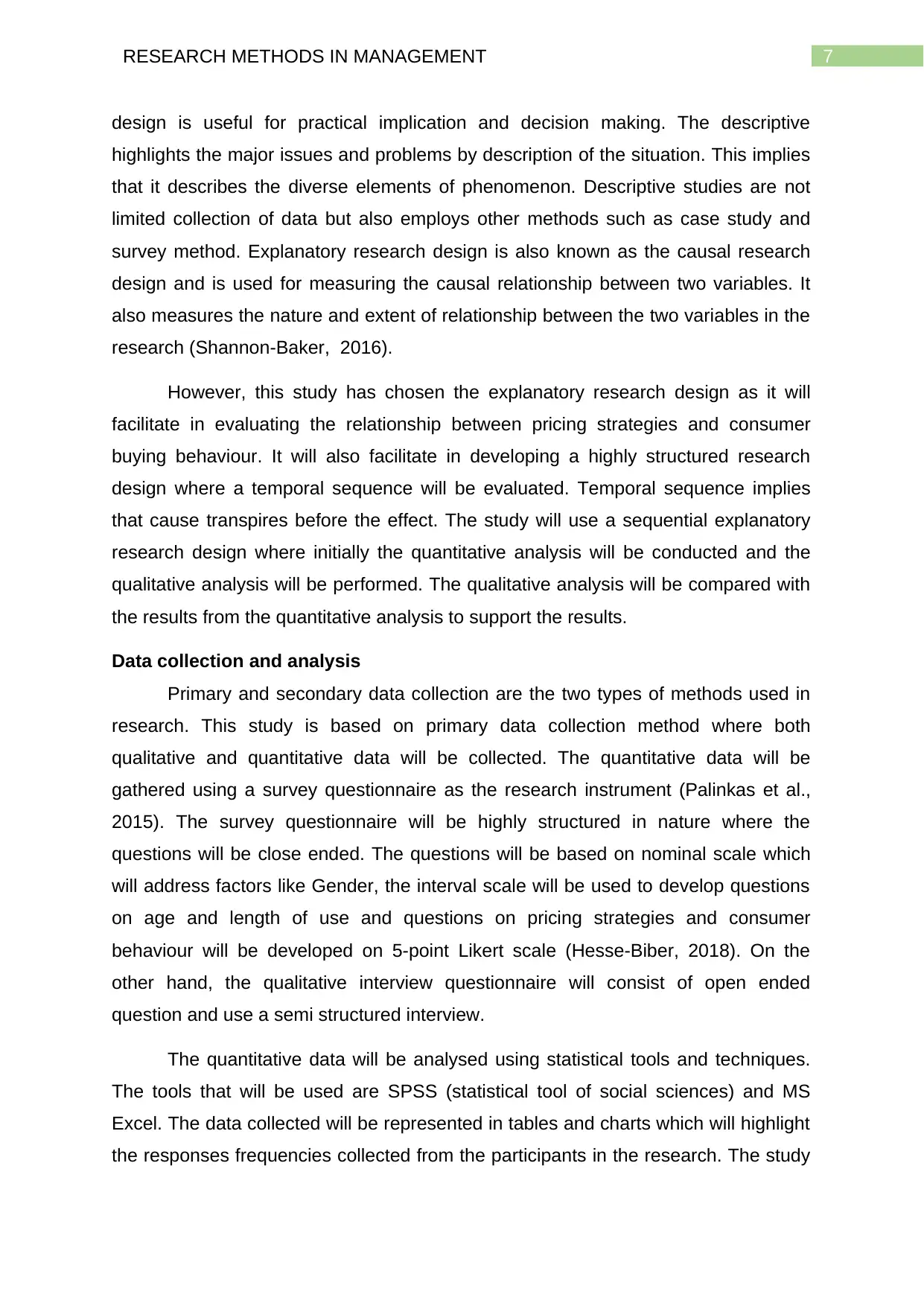
7RESEARCH METHODS IN MANAGEMENT
design is useful for practical implication and decision making. The descriptive
highlights the major issues and problems by description of the situation. This implies
that it describes the diverse elements of phenomenon. Descriptive studies are not
limited collection of data but also employs other methods such as case study and
survey method. Explanatory research design is also known as the causal research
design and is used for measuring the causal relationship between two variables. It
also measures the nature and extent of relationship between the two variables in the
research (Shannon-Baker, 2016).
However, this study has chosen the explanatory research design as it will
facilitate in evaluating the relationship between pricing strategies and consumer
buying behaviour. It will also facilitate in developing a highly structured research
design where a temporal sequence will be evaluated. Temporal sequence implies
that cause transpires before the effect. The study will use a sequential explanatory
research design where initially the quantitative analysis will be conducted and the
qualitative analysis will be performed. The qualitative analysis will be compared with
the results from the quantitative analysis to support the results.
Data collection and analysis
Primary and secondary data collection are the two types of methods used in
research. This study is based on primary data collection method where both
qualitative and quantitative data will be collected. The quantitative data will be
gathered using a survey questionnaire as the research instrument (Palinkas et al.,
2015). The survey questionnaire will be highly structured in nature where the
questions will be close ended. The questions will be based on nominal scale which
will address factors like Gender, the interval scale will be used to develop questions
on age and length of use and questions on pricing strategies and consumer
behaviour will be developed on 5-point Likert scale (Hesse-Biber, 2018). On the
other hand, the qualitative interview questionnaire will consist of open ended
question and use a semi structured interview.
The quantitative data will be analysed using statistical tools and techniques.
The tools that will be used are SPSS (statistical tool of social sciences) and MS
Excel. The data collected will be represented in tables and charts which will highlight
the responses frequencies collected from the participants in the research. The study
design is useful for practical implication and decision making. The descriptive
highlights the major issues and problems by description of the situation. This implies
that it describes the diverse elements of phenomenon. Descriptive studies are not
limited collection of data but also employs other methods such as case study and
survey method. Explanatory research design is also known as the causal research
design and is used for measuring the causal relationship between two variables. It
also measures the nature and extent of relationship between the two variables in the
research (Shannon-Baker, 2016).
However, this study has chosen the explanatory research design as it will
facilitate in evaluating the relationship between pricing strategies and consumer
buying behaviour. It will also facilitate in developing a highly structured research
design where a temporal sequence will be evaluated. Temporal sequence implies
that cause transpires before the effect. The study will use a sequential explanatory
research design where initially the quantitative analysis will be conducted and the
qualitative analysis will be performed. The qualitative analysis will be compared with
the results from the quantitative analysis to support the results.
Data collection and analysis
Primary and secondary data collection are the two types of methods used in
research. This study is based on primary data collection method where both
qualitative and quantitative data will be collected. The quantitative data will be
gathered using a survey questionnaire as the research instrument (Palinkas et al.,
2015). The survey questionnaire will be highly structured in nature where the
questions will be close ended. The questions will be based on nominal scale which
will address factors like Gender, the interval scale will be used to develop questions
on age and length of use and questions on pricing strategies and consumer
behaviour will be developed on 5-point Likert scale (Hesse-Biber, 2018). On the
other hand, the qualitative interview questionnaire will consist of open ended
question and use a semi structured interview.
The quantitative data will be analysed using statistical tools and techniques.
The tools that will be used are SPSS (statistical tool of social sciences) and MS
Excel. The data collected will be represented in tables and charts which will highlight
the responses frequencies collected from the participants in the research. The study
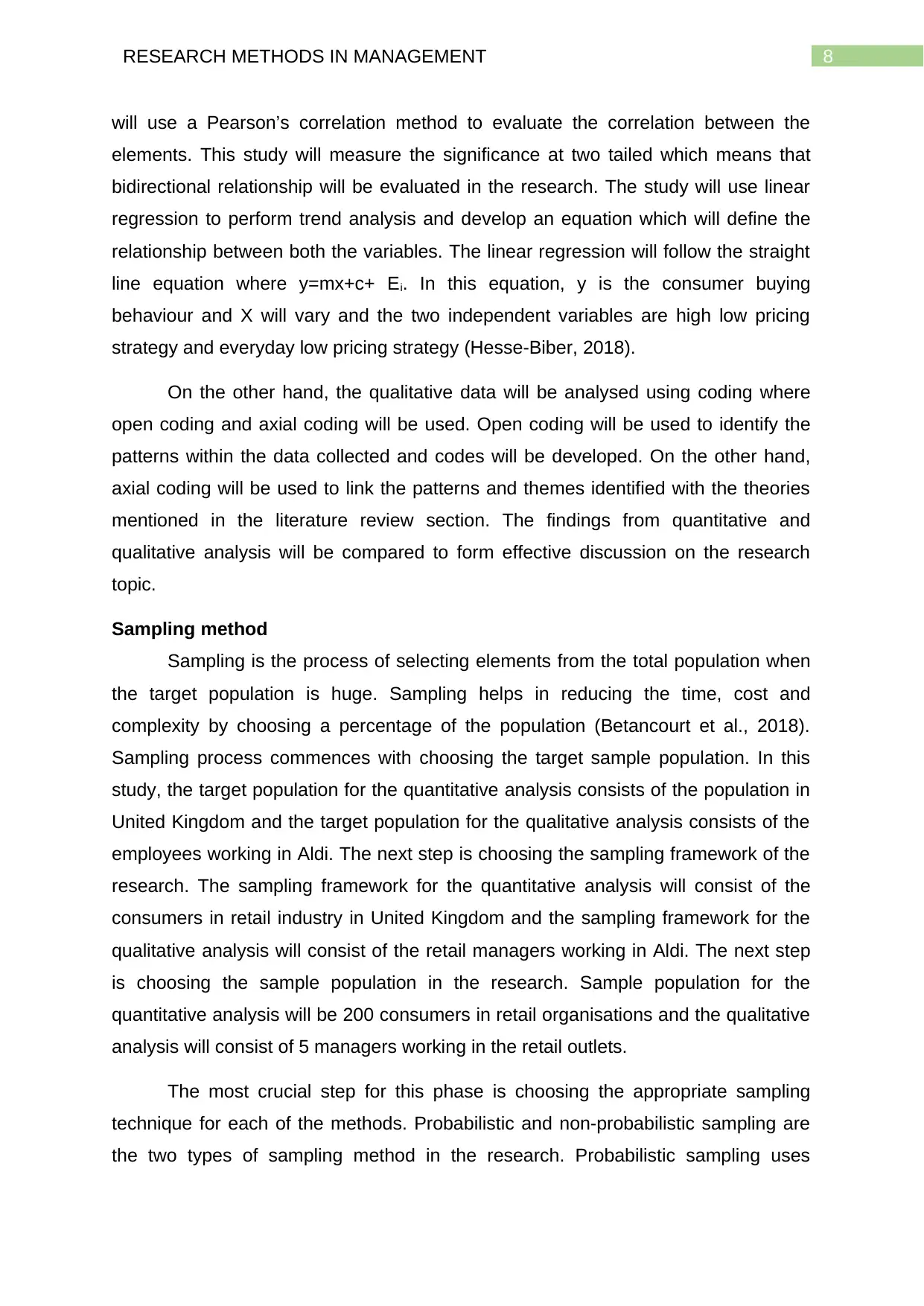
8RESEARCH METHODS IN MANAGEMENT
will use a Pearson’s correlation method to evaluate the correlation between the
elements. This study will measure the significance at two tailed which means that
bidirectional relationship will be evaluated in the research. The study will use linear
regression to perform trend analysis and develop an equation which will define the
relationship between both the variables. The linear regression will follow the straight
line equation where y=mx+c+ Ei. In this equation, y is the consumer buying
behaviour and X will vary and the two independent variables are high low pricing
strategy and everyday low pricing strategy (Hesse-Biber, 2018).
On the other hand, the qualitative data will be analysed using coding where
open coding and axial coding will be used. Open coding will be used to identify the
patterns within the data collected and codes will be developed. On the other hand,
axial coding will be used to link the patterns and themes identified with the theories
mentioned in the literature review section. The findings from quantitative and
qualitative analysis will be compared to form effective discussion on the research
topic.
Sampling method
Sampling is the process of selecting elements from the total population when
the target population is huge. Sampling helps in reducing the time, cost and
complexity by choosing a percentage of the population (Betancourt et al., 2018).
Sampling process commences with choosing the target sample population. In this
study, the target population for the quantitative analysis consists of the population in
United Kingdom and the target population for the qualitative analysis consists of the
employees working in Aldi. The next step is choosing the sampling framework of the
research. The sampling framework for the quantitative analysis will consist of the
consumers in retail industry in United Kingdom and the sampling framework for the
qualitative analysis will consist of the retail managers working in Aldi. The next step
is choosing the sample population in the research. Sample population for the
quantitative analysis will be 200 consumers in retail organisations and the qualitative
analysis will consist of 5 managers working in the retail outlets.
The most crucial step for this phase is choosing the appropriate sampling
technique for each of the methods. Probabilistic and non-probabilistic sampling are
the two types of sampling method in the research. Probabilistic sampling uses
will use a Pearson’s correlation method to evaluate the correlation between the
elements. This study will measure the significance at two tailed which means that
bidirectional relationship will be evaluated in the research. The study will use linear
regression to perform trend analysis and develop an equation which will define the
relationship between both the variables. The linear regression will follow the straight
line equation where y=mx+c+ Ei. In this equation, y is the consumer buying
behaviour and X will vary and the two independent variables are high low pricing
strategy and everyday low pricing strategy (Hesse-Biber, 2018).
On the other hand, the qualitative data will be analysed using coding where
open coding and axial coding will be used. Open coding will be used to identify the
patterns within the data collected and codes will be developed. On the other hand,
axial coding will be used to link the patterns and themes identified with the theories
mentioned in the literature review section. The findings from quantitative and
qualitative analysis will be compared to form effective discussion on the research
topic.
Sampling method
Sampling is the process of selecting elements from the total population when
the target population is huge. Sampling helps in reducing the time, cost and
complexity by choosing a percentage of the population (Betancourt et al., 2018).
Sampling process commences with choosing the target sample population. In this
study, the target population for the quantitative analysis consists of the population in
United Kingdom and the target population for the qualitative analysis consists of the
employees working in Aldi. The next step is choosing the sampling framework of the
research. The sampling framework for the quantitative analysis will consist of the
consumers in retail industry in United Kingdom and the sampling framework for the
qualitative analysis will consist of the retail managers working in Aldi. The next step
is choosing the sample population in the research. Sample population for the
quantitative analysis will be 200 consumers in retail organisations and the qualitative
analysis will consist of 5 managers working in the retail outlets.
The most crucial step for this phase is choosing the appropriate sampling
technique for each of the methods. Probabilistic and non-probabilistic sampling are
the two types of sampling method in the research. Probabilistic sampling uses
⊘ This is a preview!⊘
Do you want full access?
Subscribe today to unlock all pages.

Trusted by 1+ million students worldwide
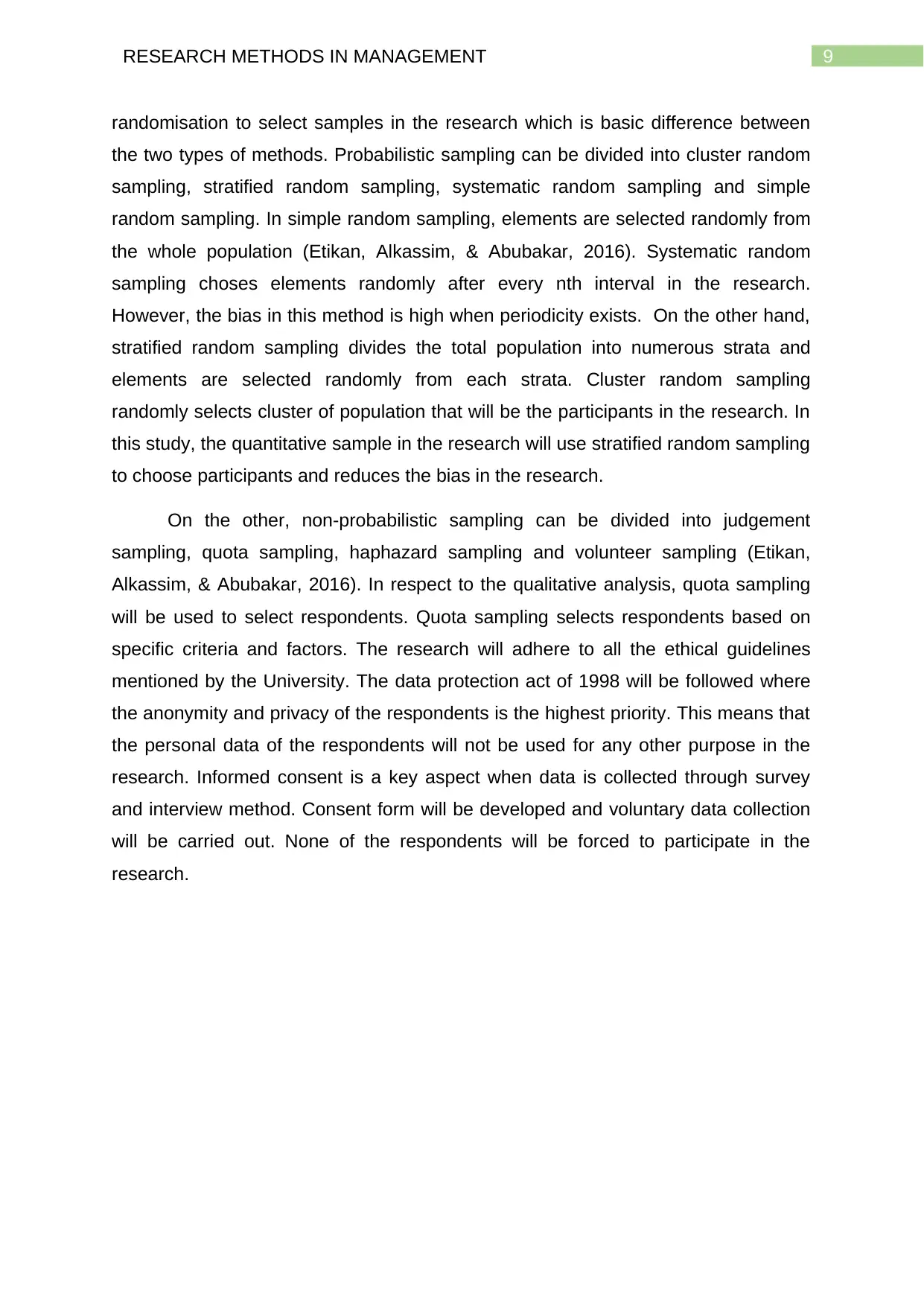
9RESEARCH METHODS IN MANAGEMENT
randomisation to select samples in the research which is basic difference between
the two types of methods. Probabilistic sampling can be divided into cluster random
sampling, stratified random sampling, systematic random sampling and simple
random sampling. In simple random sampling, elements are selected randomly from
the whole population (Etikan, Alkassim, & Abubakar, 2016). Systematic random
sampling choses elements randomly after every nth interval in the research.
However, the bias in this method is high when periodicity exists. On the other hand,
stratified random sampling divides the total population into numerous strata and
elements are selected randomly from each strata. Cluster random sampling
randomly selects cluster of population that will be the participants in the research. In
this study, the quantitative sample in the research will use stratified random sampling
to choose participants and reduces the bias in the research.
On the other, non-probabilistic sampling can be divided into judgement
sampling, quota sampling, haphazard sampling and volunteer sampling (Etikan,
Alkassim, & Abubakar, 2016). In respect to the qualitative analysis, quota sampling
will be used to select respondents. Quota sampling selects respondents based on
specific criteria and factors. The research will adhere to all the ethical guidelines
mentioned by the University. The data protection act of 1998 will be followed where
the anonymity and privacy of the respondents is the highest priority. This means that
the personal data of the respondents will not be used for any other purpose in the
research. Informed consent is a key aspect when data is collected through survey
and interview method. Consent form will be developed and voluntary data collection
will be carried out. None of the respondents will be forced to participate in the
research.
randomisation to select samples in the research which is basic difference between
the two types of methods. Probabilistic sampling can be divided into cluster random
sampling, stratified random sampling, systematic random sampling and simple
random sampling. In simple random sampling, elements are selected randomly from
the whole population (Etikan, Alkassim, & Abubakar, 2016). Systematic random
sampling choses elements randomly after every nth interval in the research.
However, the bias in this method is high when periodicity exists. On the other hand,
stratified random sampling divides the total population into numerous strata and
elements are selected randomly from each strata. Cluster random sampling
randomly selects cluster of population that will be the participants in the research. In
this study, the quantitative sample in the research will use stratified random sampling
to choose participants and reduces the bias in the research.
On the other, non-probabilistic sampling can be divided into judgement
sampling, quota sampling, haphazard sampling and volunteer sampling (Etikan,
Alkassim, & Abubakar, 2016). In respect to the qualitative analysis, quota sampling
will be used to select respondents. Quota sampling selects respondents based on
specific criteria and factors. The research will adhere to all the ethical guidelines
mentioned by the University. The data protection act of 1998 will be followed where
the anonymity and privacy of the respondents is the highest priority. This means that
the personal data of the respondents will not be used for any other purpose in the
research. Informed consent is a key aspect when data is collected through survey
and interview method. Consent form will be developed and voluntary data collection
will be carried out. None of the respondents will be forced to participate in the
research.
Paraphrase This Document
Need a fresh take? Get an instant paraphrase of this document with our AI Paraphraser
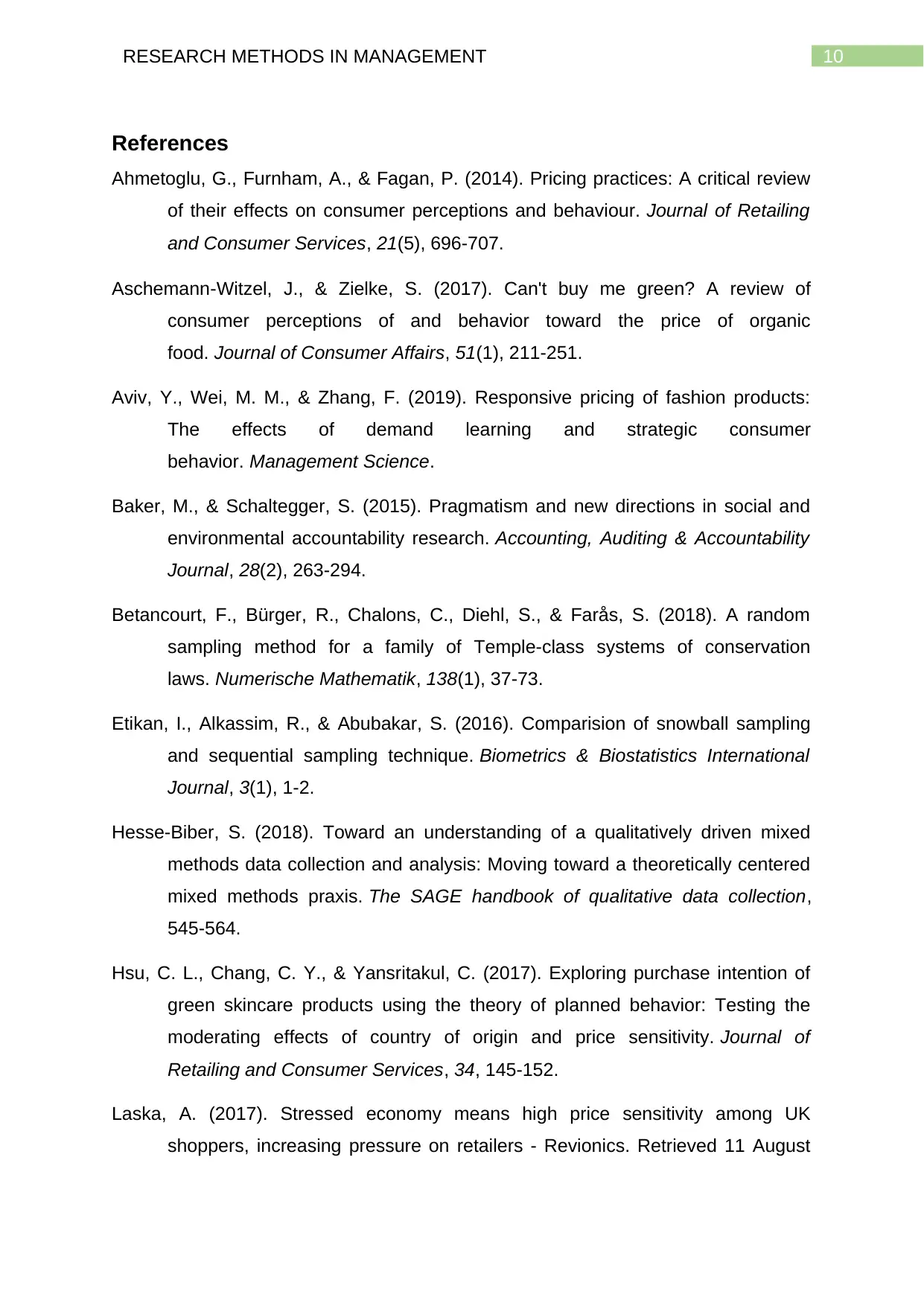
10RESEARCH METHODS IN MANAGEMENT
References
Ahmetoglu, G., Furnham, A., & Fagan, P. (2014). Pricing practices: A critical review
of their effects on consumer perceptions and behaviour. Journal of Retailing
and Consumer Services, 21(5), 696-707.
Aschemann‐Witzel, J., & Zielke, S. (2017). Can't buy me green? A review of
consumer perceptions of and behavior toward the price of organic
food. Journal of Consumer Affairs, 51(1), 211-251.
Aviv, Y., Wei, M. M., & Zhang, F. (2019). Responsive pricing of fashion products:
The effects of demand learning and strategic consumer
behavior. Management Science.
Baker, M., & Schaltegger, S. (2015). Pragmatism and new directions in social and
environmental accountability research. Accounting, Auditing & Accountability
Journal, 28(2), 263-294.
Betancourt, F., Bürger, R., Chalons, C., Diehl, S., & Farås, S. (2018). A random
sampling method for a family of Temple-class systems of conservation
laws. Numerische Mathematik, 138(1), 37-73.
Etikan, I., Alkassim, R., & Abubakar, S. (2016). Comparision of snowball sampling
and sequential sampling technique. Biometrics & Biostatistics International
Journal, 3(1), 1-2.
Hesse-Biber, S. (2018). Toward an understanding of a qualitatively driven mixed
methods data collection and analysis: Moving toward a theoretically centered
mixed methods praxis. The SAGE handbook of qualitative data collection,
545-564.
Hsu, C. L., Chang, C. Y., & Yansritakul, C. (2017). Exploring purchase intention of
green skincare products using the theory of planned behavior: Testing the
moderating effects of country of origin and price sensitivity. Journal of
Retailing and Consumer Services, 34, 145-152.
Laska, A. (2017). Stressed economy means high price sensitivity among UK
shoppers, increasing pressure on retailers - Revionics. Retrieved 11 August
References
Ahmetoglu, G., Furnham, A., & Fagan, P. (2014). Pricing practices: A critical review
of their effects on consumer perceptions and behaviour. Journal of Retailing
and Consumer Services, 21(5), 696-707.
Aschemann‐Witzel, J., & Zielke, S. (2017). Can't buy me green? A review of
consumer perceptions of and behavior toward the price of organic
food. Journal of Consumer Affairs, 51(1), 211-251.
Aviv, Y., Wei, M. M., & Zhang, F. (2019). Responsive pricing of fashion products:
The effects of demand learning and strategic consumer
behavior. Management Science.
Baker, M., & Schaltegger, S. (2015). Pragmatism and new directions in social and
environmental accountability research. Accounting, Auditing & Accountability
Journal, 28(2), 263-294.
Betancourt, F., Bürger, R., Chalons, C., Diehl, S., & Farås, S. (2018). A random
sampling method for a family of Temple-class systems of conservation
laws. Numerische Mathematik, 138(1), 37-73.
Etikan, I., Alkassim, R., & Abubakar, S. (2016). Comparision of snowball sampling
and sequential sampling technique. Biometrics & Biostatistics International
Journal, 3(1), 1-2.
Hesse-Biber, S. (2018). Toward an understanding of a qualitatively driven mixed
methods data collection and analysis: Moving toward a theoretically centered
mixed methods praxis. The SAGE handbook of qualitative data collection,
545-564.
Hsu, C. L., Chang, C. Y., & Yansritakul, C. (2017). Exploring purchase intention of
green skincare products using the theory of planned behavior: Testing the
moderating effects of country of origin and price sensitivity. Journal of
Retailing and Consumer Services, 34, 145-152.
Laska, A. (2017). Stressed economy means high price sensitivity among UK
shoppers, increasing pressure on retailers - Revionics. Retrieved 11 August
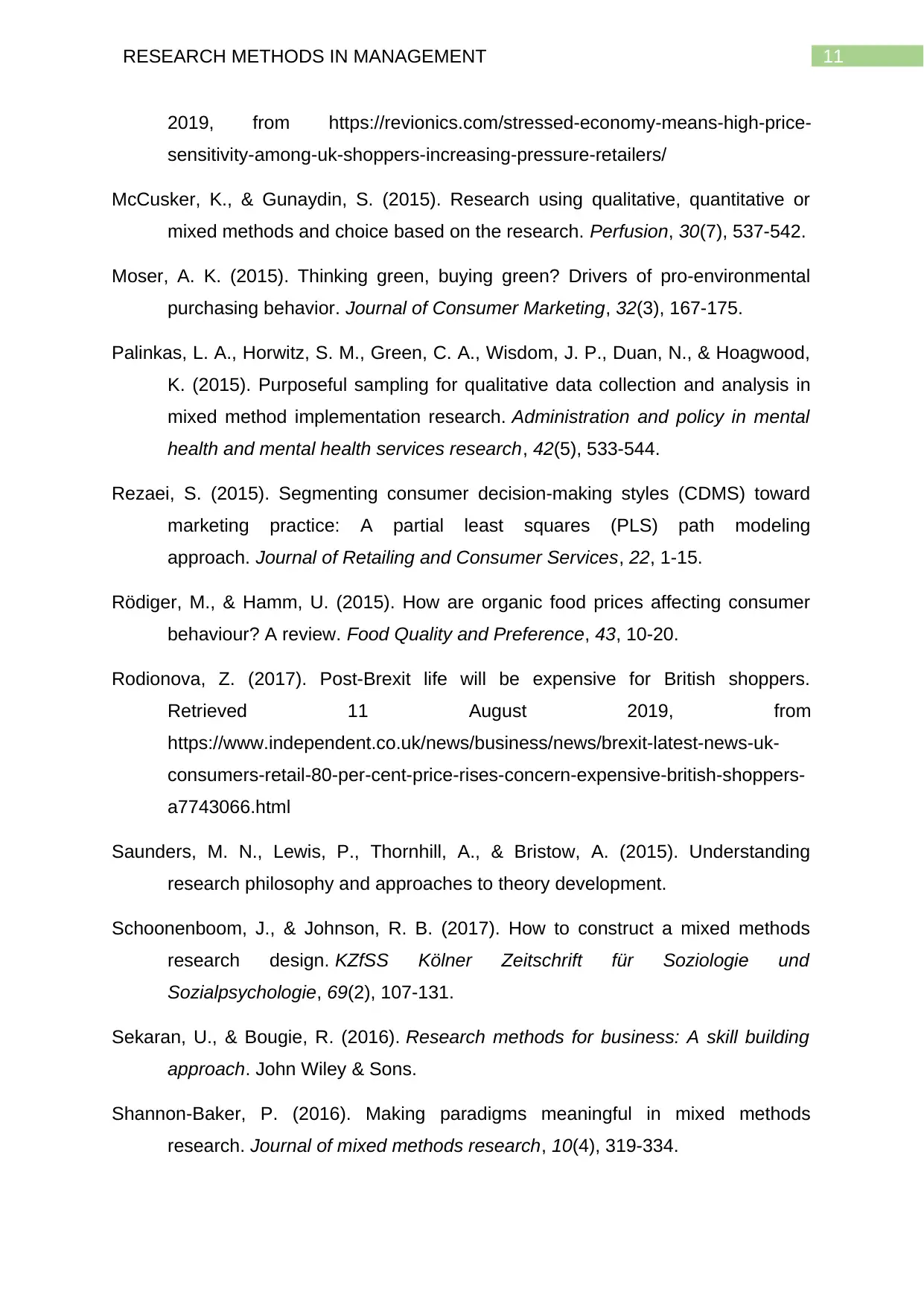
11RESEARCH METHODS IN MANAGEMENT
2019, from https://revionics.com/stressed-economy-means-high-price-
sensitivity-among-uk-shoppers-increasing-pressure-retailers/
McCusker, K., & Gunaydin, S. (2015). Research using qualitative, quantitative or
mixed methods and choice based on the research. Perfusion, 30(7), 537-542.
Moser, A. K. (2015). Thinking green, buying green? Drivers of pro-environmental
purchasing behavior. Journal of Consumer Marketing, 32(3), 167-175.
Palinkas, L. A., Horwitz, S. M., Green, C. A., Wisdom, J. P., Duan, N., & Hoagwood,
K. (2015). Purposeful sampling for qualitative data collection and analysis in
mixed method implementation research. Administration and policy in mental
health and mental health services research, 42(5), 533-544.
Rezaei, S. (2015). Segmenting consumer decision-making styles (CDMS) toward
marketing practice: A partial least squares (PLS) path modeling
approach. Journal of Retailing and Consumer Services, 22, 1-15.
Rödiger, M., & Hamm, U. (2015). How are organic food prices affecting consumer
behaviour? A review. Food Quality and Preference, 43, 10-20.
Rodionova, Z. (2017). Post-Brexit life will be expensive for British shoppers.
Retrieved 11 August 2019, from
https://www.independent.co.uk/news/business/news/brexit-latest-news-uk-
consumers-retail-80-per-cent-price-rises-concern-expensive-british-shoppers-
a7743066.html
Saunders, M. N., Lewis, P., Thornhill, A., & Bristow, A. (2015). Understanding
research philosophy and approaches to theory development.
Schoonenboom, J., & Johnson, R. B. (2017). How to construct a mixed methods
research design. KZfSS Kölner Zeitschrift für Soziologie und
Sozialpsychologie, 69(2), 107-131.
Sekaran, U., & Bougie, R. (2016). Research methods for business: A skill building
approach. John Wiley & Sons.
Shannon-Baker, P. (2016). Making paradigms meaningful in mixed methods
research. Journal of mixed methods research, 10(4), 319-334.
2019, from https://revionics.com/stressed-economy-means-high-price-
sensitivity-among-uk-shoppers-increasing-pressure-retailers/
McCusker, K., & Gunaydin, S. (2015). Research using qualitative, quantitative or
mixed methods and choice based on the research. Perfusion, 30(7), 537-542.
Moser, A. K. (2015). Thinking green, buying green? Drivers of pro-environmental
purchasing behavior. Journal of Consumer Marketing, 32(3), 167-175.
Palinkas, L. A., Horwitz, S. M., Green, C. A., Wisdom, J. P., Duan, N., & Hoagwood,
K. (2015). Purposeful sampling for qualitative data collection and analysis in
mixed method implementation research. Administration and policy in mental
health and mental health services research, 42(5), 533-544.
Rezaei, S. (2015). Segmenting consumer decision-making styles (CDMS) toward
marketing practice: A partial least squares (PLS) path modeling
approach. Journal of Retailing and Consumer Services, 22, 1-15.
Rödiger, M., & Hamm, U. (2015). How are organic food prices affecting consumer
behaviour? A review. Food Quality and Preference, 43, 10-20.
Rodionova, Z. (2017). Post-Brexit life will be expensive for British shoppers.
Retrieved 11 August 2019, from
https://www.independent.co.uk/news/business/news/brexit-latest-news-uk-
consumers-retail-80-per-cent-price-rises-concern-expensive-british-shoppers-
a7743066.html
Saunders, M. N., Lewis, P., Thornhill, A., & Bristow, A. (2015). Understanding
research philosophy and approaches to theory development.
Schoonenboom, J., & Johnson, R. B. (2017). How to construct a mixed methods
research design. KZfSS Kölner Zeitschrift für Soziologie und
Sozialpsychologie, 69(2), 107-131.
Sekaran, U., & Bougie, R. (2016). Research methods for business: A skill building
approach. John Wiley & Sons.
Shannon-Baker, P. (2016). Making paradigms meaningful in mixed methods
research. Journal of mixed methods research, 10(4), 319-334.
⊘ This is a preview!⊘
Do you want full access?
Subscribe today to unlock all pages.

Trusted by 1+ million students worldwide
1 out of 13
Related Documents
Your All-in-One AI-Powered Toolkit for Academic Success.
+13062052269
info@desklib.com
Available 24*7 on WhatsApp / Email
![[object Object]](/_next/static/media/star-bottom.7253800d.svg)
Unlock your academic potential
Copyright © 2020–2025 A2Z Services. All Rights Reserved. Developed and managed by ZUCOL.




